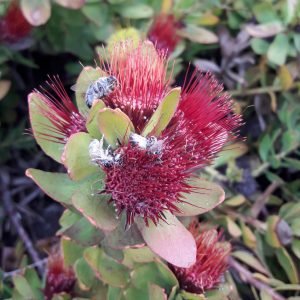Margaret Hodge
Finding many dead bee bodies in a beautiful shrub prompted a search for how they died.
Gorgeous Leucospermum Oleifolium blossoms around the end of December in our Daylesford garden. The flowers of this southern African shrub are yellow when they first open, then change through bright orange to brilliant red as they age, with all three colours present at the same time. These rich colours, on compact stems with olive-green leaves, make a great centrepiece for a Christmas table.

Dead bees in Leucospermum Oleifolium flowerheads. (Photo: M. Hodge)
But there is a catch. It can be difficult to avoid bee corpses that are embedded in lots of the flowerheads. So many dead! Some appear to have been stabbed by the plant; but can that be true? How could a flower stab a fast-moving insect?
A L. Oleifolium flowerhead contains many small flowers neatly arranged in concentric circles. Each young bud has a style coiled down tightly within it. (See feature photo.) As the flower develops the style grows very quickly and rips through the encompassing bud to emerge as a curved style. It springs upright and stands like a pin that inspired the plants common ‘pincushion’ name. Flowers on a single flowerhead open after each other over days or weeks, giving the yellow flowerhead its distinctive mix of curved styles and straight pins.
Bees visit open L. Oleifolium flowers to feed on the sweet nectar in them. They love it. As the bees work, they move between straight pins and over curved styles to reach into the flowers.
Sometimes a bee is unlucky. A style springs up like a tiny spear and stabs it. Death! Hopefully it was quick. It might have happened that way for some of the stricken bees if the style moves that fast. Does it? And most of the dead bees were not stabbed, so why did they die?
Two defence systems may have worked against the bees: signalling and stinging. When a bee senses danger it warns other bees by signalling to them, which can bring them to look for the threat. An alarmed bee can also sting the threat, but this usually has a deadly cost for the bee.
Selena Smith, President of the Daylesford and District Horticultural Society, explained it clearly. When struck by an unfurling style but not killed, “the bee sends out a distress signal to other bees, signalling ‘Help!’ They come and sting the plant. So does the struck bee. That’s what bees do. And bees die when they sting.” This is true for introduced honey bees but most Australian bee species can sting more than once. The bodies looked like honey bees. This is probably how they died. Some bee bodies may have been pierced after death, giving the appearance of stabbing.
Masses of bees continue to keenly work the L. Oleifolium shrub in spite of the dead bodies among the flowers. The nectar must be worth more to them than a few workers sacrificed in the line of duty. Fortunately the risky shrub is just one of many options they have for feeding.
Margaret Hodge is a Daylesford resident and a committee member of the Daylesford and District Horticultural Society.





